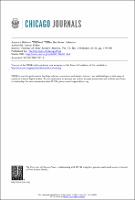Please use this identifier to cite or link to this item:
https://hdl.handle.net/20.500.12202/4440| Title: | Ancient Hebrew מעצד and עצד in the Gezer Calendar. |
| Authors: | Koller, Aaron |
| Keywords: | verbs cutting tools scribes Adzes nouns words artisans lexicography agriculture |
| Issue Date: | 2013 |
| Publisher: | The University of Chicago |
| Citation: | Koller, Aaron. (2013). Ancient Hebrew מעצד and עצד in the Gezer Calendar. Journal of Near Eastern Studies, 72(2), 179-193. |
| Series/Report no.: | Journal of Near Eastern Studies;72(2) |
| Abstract: | (From conclusion): To summarize, therefore, it has been seen that the Hebrew noun מעצד refers to the “adze” throughout the history of ancient Hebrew: it is found twice in the Hebrew Bible, in relatively unrevealing contexts, and often in rabbinic literature, in contexts that make the identification clear. Hebrew is unique among the Semitic languages in having a noun from the root עצד which refers to a carpentry tool; in other languages, cognates refer to agricultural tools and other cutting tools, but not to the tools of the carpenter. Although the literary corpus of Hebrew (Biblical through Mishnaic) does not contain any attestations of the verbal root עצד , this root is attested in the Gezer calendar. Since flax ( פשת ) is “uprooted” rather than “cut,” however, the use of עצד in the Gezer calendar does not match the data regarding the semantics of the root within Hebrew. Instead, I have suggested the connection of Gezer’s עצד with Aramaic חצד , and posit that in the dialect of the scribe, the ע and the ח were indistinguishable, at least in some contexts. |
| Description: | Scholarly article |
| URI: | http://doi.org/10.1086/671444 https://hdl.handle.net/20.500.12202/4440 |
| ISSN: | 022-2968 |
| Appears in Collections: | Yeshiva College: Faculty Publications |
Files in This Item:
| File | Description | Size | Format | |
|---|---|---|---|---|
| מעצד JNES 72 (2013).pdf | PDF author | 455.84 kB | Adobe PDF |  View/Open |
This item is licensed under a Creative Commons License

